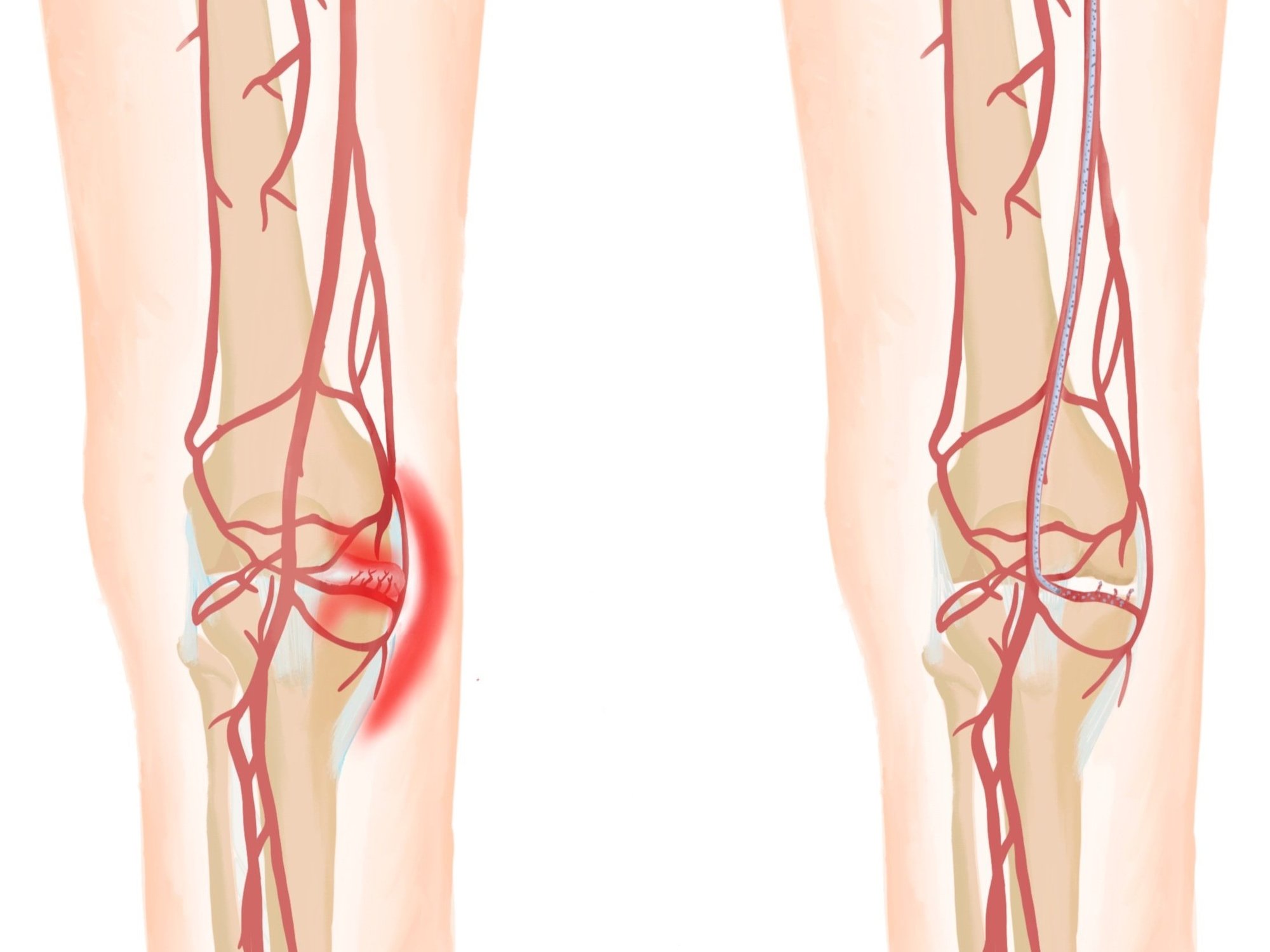Genicular Artery Embolisation
Genicular artery embolisation (GAE) is a cutting-edge, minimally invasive procedure designed to alleviate knee pain, primarily caused by osteoarthritis (OA). It is considered an alternative to recurring knee joint steroid injections for people not yet ready for knee replacement.


What is Genicular Artery Embolisation?
Genicular artery embolisation (GAE) is a state-of-the-art medical procedure that offers a non-surgical solution to chronic knee pain. Unlike traditional surgical interventions, GAE is minimally invasive, targeting the very source of the pain without the need for extensive surgery.
A small catheter is inserted and tiny particles are delivered to the area of inflammation, restricting blood flow. This restriction reduces knee pain, as less blood to the area means less inflammation.
Please note that Dr Shaun Quigley can currently only see patients with private health care, and there is an out of pocket expense of $500 for the procedure.
How Effective is Genicular Artery Embolisation?
GAE is an effective treatment for knee osteoarthritis pain, reducing inflammation, pain, swelling, and stiffness by limiting blood flow. Research shows a 99.7% technical success rate, 30% to 50% pain reduction, only 5% needing knee replacement within 2 years, and 8.3% requiring follow-up treatment.
Recommended Reading: Evaluating the Effectiveness of GAE: What the Research Says
How is GAE Performed?
1. Pre-Procedure Preparations:
- Consultation: Before the procedure, the patient will have a consultation with the interventional radiologist to discuss the procedure, its benefits, risks, and to answer any questions.
- Imaging: Diagnostic imaging, such as an MRI or angiography, may be performed to visualize the knee's vascular anatomy and identify the genicular arteries.
- Fasting: Patients are typically advised to fast for several hours before the procedure.
- Medications: Some medications, especially blood thinners, may need to be adjusted or temporarily stopped.
2. Procedure Setup:
- Anesthesia: Local anesthesia is applied to numb the entry site, usually in the groin area. Sedation might also be provided to ensure the patient is relaxed and comfortable.
- Positioning: The patient is positioned on the procedure table, and the leg is prepped and draped in a sterile manner.
3. Accessing the Artery:
- Incision: A small incision is made in the groin to access the femoral artery.
- Catheter Insertion: A thin, flexible tube called a catheter is inserted into the femoral artery.
4. Navigating to the Genicular Arteries:
- Guidance: Using real-time X-ray imaging (fluoroscopy), the interventional radiologist guides the catheter through the arterial system to the genicular arteries around the knee.
- Contrast Injection: A contrast agent may be injected to better visualize the blood vessels and ensure the correct positioning of the catheter.
5. Embolisation:
- Injecting Embolic Agents: Once the catheter is in the correct position, embolic agents (tiny particles or beads) are injected. These agents block the blood flow to the targeted genicular arteries, reducing the blood supply to the inflamed synovium.
- Verification: After the embolic agents are delivered, another round of imaging may be done to confirm the successful blockage of the targeted arteries.
6. Completion of the Procedure:
- Catheter Removal: The catheter is carefully withdrawn from the artery.
- Incision Closure: The small incision in the groin is closed, either with sutures or by applying pressure to ensure there's no bleeding.
- Recovery: The patient is taken to a recovery area for observation. Vital signs are monitored, and the entry site is checked for any complications.
7. Post-Procedure Care:
- Observation: Patients are usually observed for a few hours to ensure there are no immediate complications.
- Activity: Patients are advised to take it easy for the rest of the day and avoid strenuous activities for a few days.
- Follow-up: A follow-up appointment is scheduled to monitor the patient's progress, assess pain relief, and check for any potential late complications.
Recommended Reading: A Step-by-Step Guide to Genicular Artery Embolisation for Knee Pain
Please note that Dr Shaun Quigley can currently only see patients with private health care, and there is an out of pocket expense of $500 for the procedure.
What are the Benefits of GAE?
-
Pain Relief: One of the primary benefits of GAE is significant pain reduction. Many patients experience relief from chronic knee pain after undergoing the procedure.
-
Minimally Invasive: GAE is less invasive than traditional surgical interventions like knee replacement. This means smaller incisions, less tissue damage, and typically a faster recovery.
-
Short Recovery Time: Due to its minimally invasive nature, the recovery time for GAE is generally shorter than that of surgical procedures. Most patients can return to their normal activities within a few days.
-
Avoidance of Knee Replacement: For some patients, GAE can delay or even eliminate the need for knee replacement surgery, which comes with its own set of risks and a longer recovery period.
-
Reduced Need for Medications: With the pain relief provided by GAE, many patients find they can reduce or even stop taking pain medications, which can have side effects when used long-term.
-
Preservation of Knee Function: By targeting the source of pain without altering the knee's structural components, GAE allows for the preservation of natural knee function.
What are the Risks of GAE?
-
Bruising or Hematoma: As with any procedure involving catheter insertion, there's a risk of bruising at the puncture site but this will heal on it's own over time.
-
Infection: Though rare, any procedure that involves making an incision carries a risk of infection.
-
Allergic Reaction: Some patients might have an allergic reaction to the contrast dye used during the procedure.
-
Non-target Embolization: There's a small risk that the embolic agents could travel to and block other arteries, potentially causing tissue damage.
-
Incomplete Pain Relief: While many patients experience significant pain relief, the results can vary, and some might not achieve the desired level of relief.
-
Vascular Complications: Rarely, the procedure can cause damage to the artery, leading to complications like pseudoaneurysm or arteriovenous fistula.
-
Post-embolisation Syndrome: Some patients might experience symptoms like mild fever, fatigue, or nausea after the procedure, though these symptoms are generally temporary.
What is Recovery Like?
For the first 24 hours post-procedure, it's recommended that patients limit physical activity and stay hydrated, while also being mindful of any discomfort or pain, which can usually be managed with over-the-counter pain relievers. Within a few days, most individuals can gradually resume their regular activities, though it's crucial to avoid rushing the recovery process. Proper care of the puncture site is essential, and any signs of infection or unusual symptoms should be promptly addressed. A follow-up appointment is usually scheduled within a week or two after GAE to assess the procedure's success and evaluate the patient's pain relief. Over the subsequent weeks, patients should experience a noticeable reduction in knee pain. To optimize recovery and joint health, some may benefit from physical therapy and are often advised to adopt certain lifestyle modifications, such as maintaining a healthy weight and engaging in low-impact exercises.

What Results can I Expect From Genicular Artery Embolisation?
Studies show genicular artery embolisation results last 3 to 24 months, varying by individual. Patients often report significant pain reduction and improved daily function, enhancing quality of life. Results vary based on condition severity and health.
On average, pain reduction is 30% to 50%, lasting 6 months to 2 years. Global studies support GAE as a long-term solution for knee osteoarthritis, offering a non-surgical alternative.
Who Can Undergo Genicular Artery Embolisation?
Candidates for GAE:
-
Osteoarthritis (OA) Patients: GAE is primarily recommended for individuals with knee osteoarthritis who experience significant pain and have not found relief from conventional treatments.
-
Non-Surgical Candidates: Those who are not suitable candidates for knee replacement surgery, either due to medical reasons, age, or personal choice, might consider GAE as an alternative.
-
Inadequate Response to Other Treatments: Patients who have tried other treatments, such as pain medications, corticosteroid injections, hyaluronic acid injections, or physical therapy, without adequate pain relief might benefit from GAE.
-
Seeking Minimally Invasive Options: Individuals looking for a less invasive procedure with a shorter recovery time compared to traditional surgeries might opt for GAE.
-
No Significant Joint Deformity: While GAE can alleviate pain, it doesn't correct significant joint deformities. Those with advanced osteoarthritis leading to pronounced joint deformity might need to consider other treatments.
Please note that Dr Shaun Quigley can currently only see patients with private health care, and there is an out of pocket expense of $500 for the procedure.
Will I Still Need a Knee Replacement?
The primary goal of GAE is to alleviate the pain associated with knee inflammation caused by osteoarthritis. Extensive studies have demonstrated significant improvement in knee pain scores for the majority of patients within the first week, providing lasting relief. However, it is important to note that GAE does not address existing cartilage damage, and therefore a knee replacement may still be necessary in the future.
Will this prevent me from getting a knee replacement in the future?
Receiving GAE doesn't hinder your ability to undergo a knee replacement in the future. GAE specifically focuses on addressing the abnormal arteries formed due to inflammation, leaving the normal arteries to the knee unaffected. In fact, GAE is occasionally performed after knee replacement to decrease post-operative bleeding known as haemarthrosis.
Safe, effective treatments with less pain and quicker recovery.
Ensure you know all your options prior to invasive surgical treatment, schedule a consult with Dr Shaun Quigley.


